Repulsion - Study guides, Study notes & Summaries
Looking for the best study guides, study notes and summaries about Repulsion? On this page you'll find 653 study documents about Repulsion.
Page 3 out of 653 results
Sort by
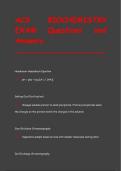
-
ACS BIOCHEMISTRY EXAM Questions and Answers
- Exam (elaborations) • 42 pages • 2024
- Available in package deal
-
- R242,48
- + learn more
Henderson-Hasselbach Equation Ans- pH = pKa + log ([A-] / [HA]) Salting Out (Purification) Ans- Changes soluble protein to solid precipitate. Protein precipitates when the charges on the protein match the charges in the solution. Size-Exclusion Chromatography Ans- Separates sample based on size with smaller molecules eluting later. Ion-Exchange Chromatography Ans- Separates sample based on charge. CM attracts +, DEAE attracts -. May have repulsion effect on like charges. Salt or acid ...
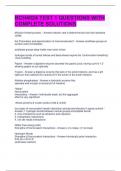
-
BCH4024 TEST 1 QUESTIONS WITH COMPLETE SOLUTIONS
- Exam (elaborations) • 16 pages • 2024
-
- R237,09
- + learn more
BCH4024 TEST 1 QUESTIONS WITH COMPLETE SOLUTIONS diffusion-limited process: - Answer-reaction rate is determined by how fast reactants collide the Protonation and deprotonation of macromolecules? - Answer-acid/base groups on surface react immediately acid/base groups deep inside may never ionize hydrogen bonds of buried helices and beta-sheets require the "conformation breathing" -local unfolding Pepsin - Answer-a digestive enzyme secreted into gastric juice, having a pH of 1.5 a...
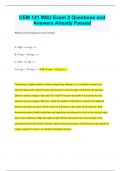
-
CEM 141 MSU Exam 2 Questions and Answers Already Passed
- Exam (elaborations) • 15 pages • 2024
- Available in package deal
-
- R179,57
- + learn more
CEM 141 MSU Exam 2 Questions and Answers Already Passed Which reaction requires the most energy? A. N(g) → N+(g) + e - B. N+(g) → N2+(g) + e - C. F(g) → F+(g) + e - D. F+(g) → F2+(g) + e - D. F+(g) → F2+(g) + e - Fluorine has a higher effective nuclear charge than Nitrogen - so it is harder to remove an electron (takes more energy because the electron is more strongly attracted by the nucleus). Effective nuclear charge is the same for F and F+ because the number of pro...
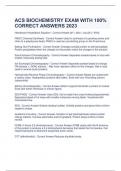
-
ACS BIOCHEMISTRY EXAM QUESTION WITH COMPLETE SOLUTIONS LATEST 2023/2024
- Exam (elaborations) • 18 pages • 2023
- Available in package deal
-
- R197,55
- + learn more
ACS BIOCHEMISTRY EXAM QUESTION WITH COMPLETE SOLUTIONS LATEST 2023/2024 COMPLETE SOLUTIONS LATEST 2023/2024 Henderson-Hasselbach Equation - ANSWER pH = pKa + log ([A-] / [HA]) FMOC Chemical Synthesis - ANSWER Use d in synthesis of a growing amino acid chain to a polystyrene bead. FMOC is used as a protecting group on the N-terminus. Salting Out (Purification) - ANSWER Changes soluble protein to solid precipitate. Protein precipitates when the charges on the protein match the charges in the solu...
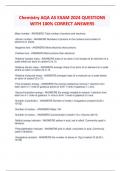
-
Chemistry AQA AS EXAM 2024 QUESTIONS WITH 100% CORRECT ANSWERS
- Exam (elaborations) • 10 pages • 2024
-
- R251,47
- + learn more
Chemistry AQA AS EXAM 2024 QUESTIONS WITH 100% CORRECT ANSWERS Mass number - ANSWERS Total number of protons and neutrons. Atomic number - ANSWERS Numbers of protons in the nucleus and number of electrons in shells. Negative Ions - ANSWERS More electrons than protons. Positive ions - ANSWERS More protons than electrons. Relative isotopic mass - ANSWERS mass of an atom of an isotope of an element on a scale where an atom of carbon12 is 12. Relative atomic mass - ANSWERS average mass o...
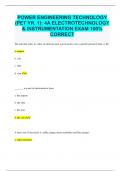
-
POWER ENGINEERING TECHNOLOGY (PET YR. 1): 4A ELECTROTECHNOLOGY & INSTRUMENTATION EXAM 100% CORRECT
- Exam (elaborations) • 53 pages • 2024
- Available in package deal
-
- R215,52
- + learn more
POWER ENGINEERING TECHNOLOGY (PET YR. 1): 4A ELECTROTECHNOLOGY & INSTRUMENTATION EXAM 100% CORRECT The unit that refers to a flow of electrons past a given point, over a specific period of time, is the: a. ampere b. volt c. ohm d. watt a _______ is a unit of electromotive force. a. the ampere b. the ohm c. the watt d. the volt d A basic law of electricity is, unlike charge attract eachother and like charges: a. repel eachother b. hold eachother c. attract eachoth...

-
AQA A LEVEL Chemistry Questions & Correct Answers/ Graded A+
- Exam (elaborations) • 23 pages • 2024
- Available in package deal
-
- R228,10
- + learn more
Relative atomic mass : The average mass of an atom of an element, relative to 1/12th of the mass of an atom of Carbon-12 Relative molecular mass : Average mass of a molecule compared to 1/12th of the mass of a carbon-12 atom The Avogradro constant : the number of particles in a mole ideal gas equation : pV = nRT empirical formula : the simplest whole number ratio of atoms of each element in a compound 2 percentage atom economy : (Mass of desired product/total mass of reactants) x 1...
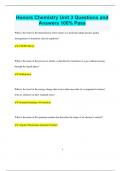
-
Honors Chemistry Unit 3 Questions and Answers 100% Pass
- Exam (elaborations) • 9 pages • 2024
- Available in package deal
-
- R179,57
- + learn more
Honors Chemistry Unit 3 Questions and Answers 100% Pass What is the term for the phenomenon where atoms in a molecule adopt specific spatial arrangements to minimize electron repulsion? VSEPR Theory What is the name of the process in which a solid directly transitions to a gas without passing through the liquid phase? Sublimation What is the term for the energy change that occurs when one mole of a compound is formed from its elements in their standard states? Standard Ent...
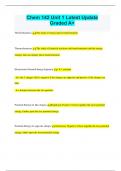
-
Chem 142 Unit 1 Latest Update Graded A+
- Exam (elaborations) • 19 pages • 2024
- Available in package deal
-
- R179,57
- + learn more
Chem 142 Unit 1 Latest Update Graded A+ Thermodynamics The study of energy and its transformation Thermochemistry The study of chemical reactions and transformations and the energy changes that accompany these transformations Electrostatic Potential Energy Equation - k = constant - Q = the 2 charges (Eel is negative if the charges are opposite and positive if the charges are like) - d = distance between the two particles Potential Energy for like charges Repulsion; Positive;...

-
AQA AS Physical Chemistry 2024 exam questions with 100% correct answers
- Exam (elaborations) • 29 pages • 2024
- Available in package deal
-
- R251,47
- + learn more
AQA AS Physical Chemistry 2024 exam questions with 100% correct answers Who described atoms as solid spheres that make up different elements and when? - ANSWERS John Dalton in the 19th century Who suggested that atoms of a particular element had the same mass and atoms of different elements had different masses and when? - ANSWERS John Dalton in 1803 Who discovered the electron and when? - ANSWERS JJ Thomson, 1897 discovered electrons proving atoms weren't indivisible or solid. New m...

Study stress? For sellers on Stuvia, these are actually golden times. KA-CHING! Earn from your study notes too and start uploading now. Discover all about earning on Stuvia


